Orang Ikan
Posted by: Loren Coleman on July 17th, 2009
Brent Swancer, living in Japan, is our guest contributor for today. He introduces us to yet another interesting story about a unique Japanese cryptid:
Orang Ikan
by Brent Swancer
Merbeings. Whether you believe they are possible are not, it is undeniable that half human/half fish beings (above) are a recurring theme around the world and across cultural divides. In light of the recent talk of merbeings at Cryptomundo (see here, here & here), I thought I would share an interesting case that was reported by Japanese soldiers from the Kei Islands of Indonesia in 1943.
The Kei Islands, also known as the Kai Islands, are located in the south-eastern part of the Maluka Islands of Indonesia. The Kei Islands cover a total area of around 555 square miles and are famous for their beautiful beaches and unspoiled scenery. It was in this gorgeous island paradise of postcard perfect, pristine white sand beaches that a most peculiar and mysterious case occurred.
In 1943, Japanese soldiers stationed with a surveillance team on a small, remote island within the Kei island chain reported seeing strange creatures in the water that were said to have limbs and a face somewhat similar to a human, but a mouth like a carp. These creatures were described as being around 150 cm tall, and having pink skin, as well as prominent spines on their heads. Unlike classical mermaids, these merbeings did not have fish tails, but rather two arms and two legs.
On several occasions, these beings were seen cavorting about near beaches or in lagoons. In one case, two of the odd creatures were spotted playing in a lagoon, and another was reportedly seen swimming near a beach in a manner similar to a human doing the breast stroke. One report was told by a startled soldier who recalls seeing one of the creatures on a beach one night. At first the soldier had thought it was a child until it turned around and he could see in the moonlight that its facial features were not quite right. The creature quickly ran headlong into the water upon being seen and did not resurface.
Although the Japanese soldiers were deeply perplexed by these sightings, these creatures were not unknown to the indigenous people of the islands. When asked about them, villagers in the vicinity told the Japanese that they were known locally as the Orang Ikan. In Malay, Orangmeans “human” and Ikan means “fish,” so we have something akin to “man fish.” The villagers said that they were sometimes even caught in nets and that if another was captured in such a fashion, the Japanese would be informed.
One evening, the sergeant of the surveillance team, a Mr. Taro Horiba, was summoned by the chief of the nearby village. It was announced to Horiba that an Orang Ikan had been found dead on a beach earlier that day and the body was available for viewing. The sergeant was dumfounded by what he was to find sprawled out upon the grass at the chief’s home.
Horibe described the dead creature as being around 160 cm long and possessing a head of red-brown, shoulder length hair, and spines along the neck. The face was said to be quite ugly, with human-like and ape-like features; a low, short nose, a broad forehead, and small ears. The lipless mouth was wide like that of a fish, specifically described like that of a carp, and filled with tiny, needle-like teeth. The creature’s fingers and toes were long and webbed. Horiba also reported that there was some sort of algae attached all over its body.
Sergeant Horiba, although having sighted the Orang Ikan himself on several occasions, could not fathom what it was that he had seen at the chief’s home. There was no known creature residing on the island that could have possibly accounted for the dead creature he had witnessed, and the sight of the carcass had deeply disturbed him. Upon returning to Japan, Horiba told of his experiences and urged zoologists to go investigate the phenomena, but no one took him seriously. The fact that he had taken no photos did not help his cause, and in the end he was mostly ridiculed.
What is it these soldiers were seeing? What was that carcass at the chief’s house? Could there have been a real animal behind this case? The local villagers certainly seemed to think so, so here we have a classic case of an ethnoknown animal coming to the knowledge of baffled outsiders. It does not appear that these mysterious merbeings can be merely attributed to the wild imaginings of the foreign Japanese in a strange land under harsh conditions.
There is really no hard evidence available, but let’s take a moment to explore some possibilities.
Many merbeing sightings have been attributed to misidentifications of dugongs or manatees. Dugongs, although rare, were once found all over the Indo Pacific and could very well have existed in the areas of these Indonesian sightings. However, it seems unlikely that dugongs could be the culprit behind the reports of the Orang Ikan. Dugongs do not have two arms and two legs like Orang Ikan were reported to have, and it does not seem that a dugong’s face could be misconstrued as being all that human-like. Villagers would also have likely been able to make a distinction between any dugongs in the area and a merbeing. It was most definitely not the body of a dugong that sergeant Horiba described seeing at the village chief’s house.
What else could these strange creatures have been?
When pondering this case, I cannot help but notice the resemblance between these Orang Ikan and some other types of aquatic, ape-like beings that have been reported elsewhere. The Thetis Lake Gillman that was sighted at Thetis Lake on Vancouver Island in 1972, for instance, seems to share some Orang Ikan characteristics, as does the Pugwis merbeings of Native lore.
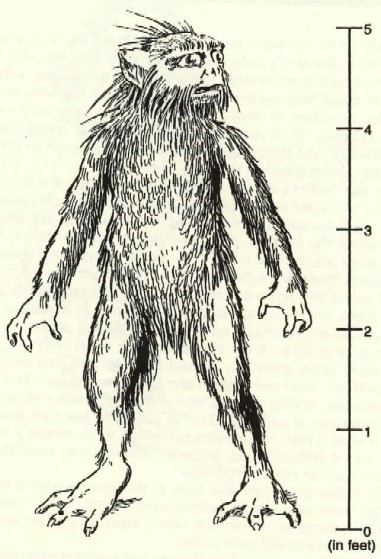
The Thetis Lake Monster above was drawn by Harry Trumbore for The Field Guide of Bigfoot and Other Mystery Primates.
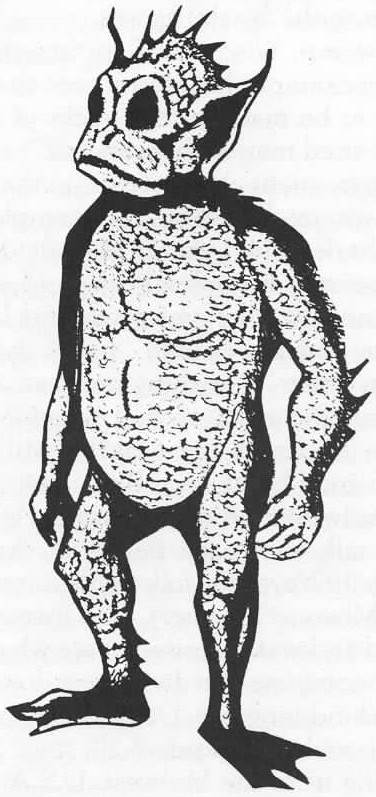
Newspaper version of the Thetis Lake Monster.
Pugwis and the Thetis Lake Monster, like the Orang Ikan, feature prominent spines or spikes on the head, two arms, two legs rather than a fish tail, webbed fingers and toes, and generally appear to be amalgam of ape and fish features. Could the Orang Ikan reported by the Kei Island natives and Japanese soldiers have been a similar sort of creature to these other cryptids?
One possibility is that all of these accounts have their basis in some sort of unknown primate that diverged long ago to adapt to an aquatic or semi-aquatic life. We could certainly expect such a primate to evolve some of the aquatic features mentioned in relation to the Orang Ikan, the Pugwis, and Thetis Lake monster. It is likely that an aquatic adapted ape-like creature would look more like these creatures than the classical mermaid image of a perfect human torso upon a perfectly fish-like tail.
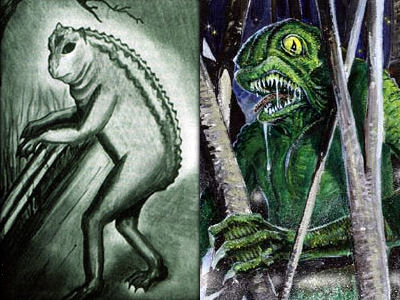
The Loveland Frog (two images above) also seems reminiscent of these ape-like Merbeings, as does the Kappa from Japan (below). Could the Orang Ikan be related to those cryptids, in some fashion?
The particular location of the Orang Ikan sightings also leads me to speculate on another possibility. The relatively recent unearthing in Indonesia of the fossils of Homo floresiensis also known as “Flores Man” or “the real Hobbit,” shows us that there was once a previously unknown type of pygmy hominid found there. It is not known what the specific range of Homo floresiensis was, and it seems possible they could very well have inhabited other Indonesian islands in addition to Flores island.
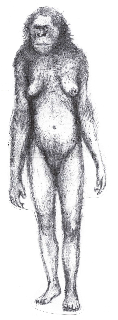
Professor Richard Klyver’s sketch of the Flores woman. The first fossil discovery of Homo floresiensis was of a female, not a male, although the media insist on labeling it the “Flores Man.”
Is it possible that these Flores hominids were also present on the Kei islands,and at some point adapted to a more aquatic habitat in this geographically isolated environment? It is thought by some researchers that Homo floresiensis may have had its small size due to island dwarfism, which is one possible adaptation to cope with limited resources in an island ecosystem. Perhaps an isolated population of Homo floresiensis could have dealt with the same pressures by adapting to a more aquatic lifestyle to take advantage of coastal resources. Coastal areas provide rich potential for food resources, so it does not seem completely unfeasible that a primate or early hominid could have perhaps evolved along these lines.
Could an aquatic adapted population of Homo floresiensis or some sort of primate explain these Indonesian merbeings? Or was it something else?
Whatever they were, the Orang Ikan presents a curious and little known mystery that has never been solved.
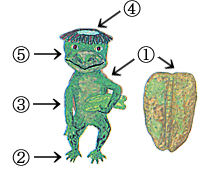
Key to the above Kappa drawing:
1) Shell,
2) Webbed hands and feet,
3) Elastic arms,
4) Plate, and
5) A tapering mouth.
About Loren Coleman
Loren Coleman is one of the world’s leading cryptozoologists, some say “the” leading living cryptozoologist. Certainly, he is acknowledged as the current living American researcher and writer who has most popularized cryptozoology in the late 20th and early 21st centuries.
Starting his fieldwork and investigations in 1960, after traveling and trekking extensively in pursuit of cryptozoological mysteries, Coleman began writing to share his experiences in 1969. An honorary member of Ivan T. Sanderson’s Society for the Investigation of the Unexplained in the 1970s, Coleman has been bestowed with similar honorary memberships of the North Idaho College Cryptozoology Club in 1983, and in subsequent years, that of the British Columbia Scientific Cryptozoology Club, CryptoSafari International, and other international organizations. He was also a Life Member and Benefactor of the International Society of Cryptozoology (now-defunct).
Loren Coleman’s daily blog, as a member of the Cryptomundo Team, served as an ongoing avenue of communication for the ever-growing body of cryptozoo news from 2005 through 2013. He returned as an infrequent contributor beginning Halloween week of 2015.
Coleman is the founder in 2003, and current director of the International Cryptozoology Museum in Portland, Maine.

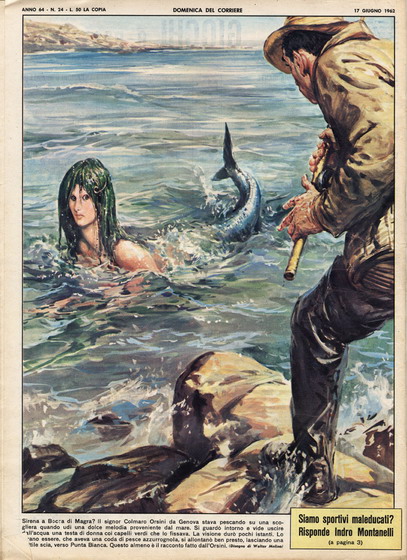
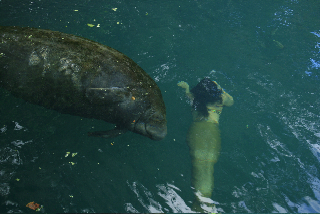










Very cool. I think this might warrant further study.
Of all the cryptid reports I’ve heard about this is one of the most baffling.
Talk about a serious disincentive to talk about something. The reaction says it all. Why in the world would numerous people just make this up? Particularly given that they served in a particularly disciplined and regimented army that could not have looked kindly on shenanigans.
I don’t really pay much attention to these cryptids, truth be told; yet the Thetis Lake monster was the first thing coming to mind on reading the description. Almost a dead ringer. Like I said: baffling.
Although it’s equally baffling why a surveillance team didn’t have a camera and get photos of the body.
This was wartime surveillance, correct? In that case, their job would simply have been to report any suspected American activity in the area. Not surprised they wouldn’t have a camera on them, but it’s a damn shame that they didn’t take the body. Out of all the aquatic creature stories, this one strikes me as the most believable. The adaptations described are consistent with what an animal living in those conditions would develop, particularly the needle like teeth (rather indicative of a piscivore) and webbing of the feet.
Indeed this truly attracts attention. I believe that these things are figments of the imagination, but I have really been bit when I said that before, so I would have to say only research can tell. With the recent uprising in new species, and creatures it is only a matter of time. Even people who dont believe in ghost have had to relook their ideas with new technology and investigation techniques. Anything is possible, or we would not be here.
Awesome story! Thanks for bringing it to our attention.
Personally I can’t take this story too seriously. The main reason being that the Japanese witnesses claimed to see the little fish-chaps on several occasions – and on those occasions the fish-chaps were ‘cavorting’ or doing the breast stroke, or playing in a lagoon… It seems pretty unlikely that they’d have sighted those creatures regularly (creatures who don’t seem particularly secretive or shy) and yet there have been no sightings since.
However I did some searches on the term Orang Ikan and I found these particularly unpleasant photos.
Yikes.
Mermaid reports to me, sound like better story-telling than factual reports, though whether there’s a factual basis to stories like these is always an intriguing possibility from my perspective. Marine animals from over the last few million years have been diverse, maybe having physical and other adaptations that to our senses might be hard to classify categorize or even identify accurately, and so reports like this conjure-up for me specualtion that some isolated coastal refugias might have supported some pretty amazing local adaptations of who knows what, but many clades over the relatively short natural history of the last few million years or so had radiated into the coastal ecosystem and adapted to them according to the fossil record. Coastal regions are the most productive of any of the earth’s ecosystems, as well as being critically vital to all it touches. So perhaps small populations lingering along a shorline too storm-chastened or inhospitable from the standpoint of humans was never practical to hunt or fish and so had remained untouched, and that over the last 12K had remained in a precarious balance. Our ability to exploit the previously unexamined areas of the earth with harvesting the superabundance of wildlife both on land and in the ocean drastically outstripped our civilization’s ability to record accurately and scientifically what was being encountered, leaving some pretty big holes in our theories about what could or couldn’t be out there.
Although I, too, have never taken mermaid stories very seriously, it is interesting to speculate that there may have been (and perhaps still is) an aquatic ape.
Elaine Morgan’s “Aquatic Ape Hypothesis” presents some pretty compelling arguments that humans evolved from apes that were at least partially aquatic in nature. She is essentially suggesting that “we” didn’t come down from the trees onto the savannah, as much as we came down from the trees into marshes and wetlands, which dried up and turned into savannah. She has some pretty good biological evidence to back up this hypthoseis.
The reason for not taking the body is simple. Think of the year(s) we are talking about here. Yes, we did have ice and electric ice makers, but such things around there I can bet was scarce. The Japanese were about doing their duty. Anyone higher in rank would have had his position for waisting resources. There have been several cryptids
seen during WWII. German Uboat saw a dinosaur thing in the Atlantic Ocean right after they sunk an Allied ship. Couldn’t stick around to check it out.
Very interesting, as always. I have always found these accounts (or tales) to be curious. On the face of it the creatures are fabulous to the point of incredulity. But this particular event, if true does seem to have more logical construction to the creatures sighted, if indeed it happened.
It does make one wonder.
I tend to agree with DWA’s interpretation. And I agree also with him that this does bear an uncanny resemblance to the Thetis Lake monster.
Good story, as always, Brent.
Very much reminds me of aquatic humanoid creatures in Wm. Hodgson’s “The boats of the Glenn Carrig”.
If this had been a German soldier, one would have to suspect that this was an attempt to curry favor by producing “evidence” that might agree with Himmler’s ideas about degenerate human races. But the Japanese had their own versions of such theories, too.
As I understand it, that aquatic ape hypothesis has some problems-to me the most damning of which is the lake of immunity we have to waterborne parasites (to me, this would be the FIRST feature we would see develop, if only because an individual with a high parasite load is weakened and much more vulnerable to death from any cause).
That being said, a ancestor which used the water as a source of food would make sense-and any ape that can use the water as a food source when other sources fail would have a significant advantage. Even more so in an area where hippos were not present (that animal is capable of biting a croc in half-not something conducive to the development of an aquatic ape!), and the water was reasonably safe. In such conditions, factors could certainly lead to a species of ape going aquatic.
By the way, here is what a carp’s mouth looks like, at least when open. It looks rather different when closed, though. What I want to know more than what it looked like, however, is the LENGTH of the mount/snout. Long, narrow jaws filled with sharp, pointed teeth is something that has come up repeatedly in piscivores. Gharials, some of the river dolphins, and even the extinct phytosaurs and some of the ancient amphibians had this adaptation, as do crocodiles to a lesser extent. The whole point of the jaw design is to aid in catching and eating slippery prey-namely, fish. If the orang-ikan exhibited this trait or its development, then I feel that is a point in favor of it’s existence, simply due to the evolutionary precedent.
As always, very interesting essay Mystery_Man.
My father was in the U.S. Navy in the South Pacific during WWII. He told me many stories of the Japanese troops (especially towards the end of the war) being poorly equipped and even having guns that almost looked homemade. If the Japanese military was in such dire straits, it doesn’t surprise me that they wouldn’t have had a camera. Whether or not they actually saw mer-beings, camera or not, is interesting and certainly debatable.
I was going to post a long observation about swimming primates and our hominid evolutionary path in the long vanished Tethy’s Sea, but here’s an interesting video of a swimming monkey.
Interesting. I didn’t know that other apes would (or could) swim with their bodies entirely submerged like that, thanks for sharing that video. It inspired me to do a little digging, and it looks like orang-utans are also capable of swimming. By the way, the picture of the ornag-tuan in that article might go some ways towards explaining what the Japanese soldiers REALLY saw. It doesn’t explain the teeth, but I think it might fit for most of the description (perhaps the feet were interpreted as being webbed due to their appearance?). I’m not sure that the average Japanese soldier would have been familiar with what an orang-utan looked like, so it’s a possibility.
A skeptic could view the above post variously. First, where did the information presented originate from? Is this a well known account and does it have any substantiation or documentation in support? Or is this based solely on a newspaper article? Has there been any investigation into this affair? In other words, do we need to take the accounts at face value?
Secondly, for the sake of argument, let us grant the Horiba/dead animal story. Let’s consider the following: an animal is found dead on a beach and it is variously described as “an actual monster, some sort of rodent-like creature with a dinosaur beak;” “incredibly odd;” “canine;” “felid;” “sorry, canids and felids don’t have beaks;” “Griffinish;” “pittbull;” like a creature in the film CLOVERFIELD; “too creepy to be real;” “a penguin;” and “a tree sloth;” among other things, as well as this anti-skeptic admonition– “Let’s see the ‘otter’ people try to explain this one.” These are comments made by folks looking at a photo of a dead, decaying racoon (see: Cryptid Washes Ashore At Montauk, Cryptomundo July 29th, 2008).
The moral of the story is that decayed animals washed up on shore are open to mistaken identification and especially inaccurate descriptions.
As to the more traditional merebeing accounts, I offer this cautionary tale (if I have my facts correct.) In the inaugural issue of CRYPTOZOOLOGY (Vol. 1, Winter 1982), anthropologist Roy Wagner wrote an article “The RI – Unidentified Aquatic Animals of New Ireland, Papua New Guinea.” Wagner investigated accounts of a local aquatic animal known as “a ri.” The animal, Wagner wrote, “is described [by locals] as an air-breathing mammal with the trunk, genitalia, arms and head of a human being, and a legless lower trunk terminating in a pair of lateral fins, or flippers.” (Page 33) Wagner gave credence to the stories of the ri, even noting that one had been caught in a net years previously.
Wagner also pointed out: “Whatever the ri may be, they are certainly not dugongs,” because the locals know what a dugong looks like. (Page 38.)
I no longer have following issues of CRYPTOZOOLOGY (I was an early subscriber for a few years). I have done a cursory search on the net to try to verify my memory of later developments in the ri saga, but to no avail. Anyway, I recall that the ri was indeed later identified as a local species of DUGONG! (If anyone has evidence to the contrary, or in verification, please chime in!)
Wagner inadvertently offered a clue to the origin of the ri merebeing/dugong confusion. He wrote:
“There is a tendency for natives to identify ri with the depictions of mermaids they have seen on matchbooks covers or fish cans…” (Page 33.)
So, we have either the classic mis-identification of dugongs as meremaids (ri) based upon suggestion, or the locals were putting one over on a gullible cryptozoologist.
Actually, I found here a second account of an orang-utan swimming (albeit this time, it had no choice but to sink, swim, or starve), though this time it had a little help. These both ultimately originate from the Borneo Orang-utan survival organization, by the way.
In addition to swimming, the orang outangs were catching killing and eating fish and (humorously) stealing from fishing lines. This behaviour may explain some sightings of mermaids but then opens up the possibility of an evolved swimming ape whose diminished remnants may still find a niche in the worlds oceans and thus not just explain away mermaid sightings but in fact be mermaids. Orangs evolution in that direction would have mainly been acheived by their great curiosity, versatility and learning ability.
The black Celebes macaque is a keen swimmer seeming to do it for fun and to keep cool and clean. Swims under water with alacrity. Not sure if it finds food in water though but with the ebb and flow of evolution might still go that way.
The omnivorous crab eating macaque is also in the frame not aware of it doing much swimming but I think it more likely to than not having a wide range and natural variation.
So in one way these examples suggest the orang ikan is a known swimming ape or monkey on the other hand they suggest the orang ikan is quite possibly something new.
Jerry, you’re right about the Ri – those were identified as dugongs at some point. However, I would be hesitant to apply that here – this story specifically mentions animals with two legs, something quite different from dugongs.
(By the way, I had a discussion with a few people about the Montauk Monster – all the explanations you quoted were used, including the final one of a dead raccoon)
An ape’s hands are not very well-adapted to fishing, but there are other marine resources that hands would be very good at picking up: shellfish, crabs, crayfish, etc. I would expect any mer-hominids to tend in that direction.
Good comments and insights all around on this. I was really curious to see what you all thought of this account. I thought I would give some of my own thoughts on some of the things that have been said here as well as this story in general.
First of all, this seems to be a very obscure case. I came across this story while researching Japanese mermaids in Japanese language sources. I had never heard of this story before and so I did some more digging, scoured Japanese language sites, and came up with what you see here. I was not able to find anything about this in English language sources, and it even in Japanese sources, details were somewhat scarce. What you see here was absolutely all of the information I was able to glean out of this account and try as I might, I cannot find anything further that has not been mentioned here. It seems like this is a forgotten wartime cryptid account that for whatever reason never gained any more notoriety. It is one of the reasons I wanted to bring it to Cryptomundo’s attention and see what you all thought. I have dug up obscure Japanese cryptids here before and I’d like to think it my own small contribution here.
To answer jerrywayne’s question, I got this information from several Japanese cryptozoology sites that gave overviews of the Orang Ikan case. According to these sites, the information originates from newspaper articles and some journal entries made by the soldiers themselves, including the testimony of Horiba. I cannot say how much veracity the reports hold, and I am certainly not advocating that we take all obscure accounts such as this at face value. Far from it. I am merely reporting what I have found and presenting it for your consideration.
Some general observations on what has been brought up thus far. I’m not sure how much the the dugong and ri cases hold up here. These Orang Ikan are described as having two legs, which no matter how you cut it, is not consistent with a dugong. Other features don’t really add up with a dugong either, for instance the spines on the head or neck, and the sharp, needle like teeth. Also, there was the report of one sitting on a beach and running into the water, which dugongs certainly don’t do. Something like the Montauk Monster might be a more accurate comparison of at least the Orang Ikan carcass, if it was indeed a mundane creature, or even a real creature at all.
The idea of swimming Orangutans is interesting, but I don’t know if this behavior would be seen often enough for the local people to come up with an entirely new aquatic animal rather than just saying “Yeah, those are orangutans, they like to swim around these parts.” Perhaps in this environment orangutans might have adapted this behavior to a larger extent than elsewhere, however then we have to contend with the physical descriptions of Orang Ikan, which don’t really seem to match with orangutans. If these were actual creatures, it seems that they had evolved at least a few aquatic adaptations.
I think a very curious detail is the account of the Orang Ikan spotted on land. That points to a creature that is semi-aquatic rather than spending all of its time in the water. It reminds me of some primates like Japanese macaques or others that make at least some use of aquatic resources. Perhaps the Orang Ikan has just gone a step further and more fully evolved to access these resources, yet is still at a a stage where it is on land some of the time. From descriptions, it does seem like the creature is not completely evolved to a fully aquatic life but is maybe in the process of going in that direction. It is an interesting line of speculation.
Another thing that strikes me about the descriptions of the Orang Ikan is some of the details described, such as long, webbed fingers, the carp-like mouth, and needle like teeth. These are all perfectly logical biological adaptations for an aquatic adapted animal, and as has been mentioned, have precedent in the natural world. I just get the impression that if this is a primate, then it is not one that is known, or is a known one that has diverged at some point to a more aquatic life. I do find the mention of algae growing on the body to be curious too.
Some people here have talked about why the soldiers didn’t do more to document evidence. I think that might have something to do with their reasons for being on the island in the first place. This was a military surveillance team, with a duty to perform. There primary purpose was not to research and document the wildlife they may come across; they had more pressing matters at hand. So no matter how incredible they found the Orang Ikan to be, further investigation was just not their imperative, and not within the scope of their limited time and resources. It was not their mission, and if you understand the mentality of Japanese soldiers at the time, you will realize that they were actually really not inclined to pursue matters that were not within their mission. If it was not their responsibility, it was for someone else to do, and World War II abounds with stories of this cultural aspect in action, often to the overall detriment of their war effort.
The lack of photos is weird, but really, they simply may not have thought it was their duty to do that. Japanese soldiers really were quite regimented with what they were and were not supposed to be doing. Photos of wildlife would be something for another team to come back and do.
Another thing, about why this creature would not be more known and seen by others. I do not know the specific island that this occurred on, but I do know this was a remote island located in the Kei island chain. It was probably intentionally chosen as a remote and obscure location due to the military nature of the mission. It is quite likely that outsiders before and after the arrival of the Japanese team were scare or nonexistent.
Remember that Indonesia is made up of well over 17,000 individual islands, and not all of them are well frequented by visitors. Maybe what we had here was an isolated island little known to outsiders, where the ethnoknown Orang Ikan was first encountered by the outside world by way of the Japanese. The creature was well known to the locals, so maybe the lack of further reports and notoriety was because there just wasn’t really any traffic through there by foreigners other than this war time surveillance team. I would be interested to know what the status on this creature would be in modern days.
Anyway, I am not sure what we are dealing with here. Maybe it was nothing but some soldiers spooked by unfamiliar mundane animals and local mumbo jumbo. However, I find this account to be fascinating and hold open the possibility that the unfamiliar animal they were seeing might have been something never documented.
The dugong solution would not apply here, of course. My objective was to show how “traditional merebeing” accounts have indeed been linked to dugongs, even very recently. Some folks have found it very unlikely that meremaid stories can be attributed to dugongs, as conventional thought suggests, and even throw out a term like “scoftic” in reply.
The ri incident is a very good counterpoint to this line of thought.
Well, the traditional merbeing stories do have a long history of being linked to dugongs and the like, and that has by now become one of the first things I check for when reading these stories – does it sound like it might be a dugong. With stories like the present one, I am comfortable with taking a more in-depth look at it, because the answer to that initial question was no.
(If anyone ever combines the interest and the resources, I would really like to see some effort to try and identify the actual island mentioned here)
Even if an ape adapted to water, it would almost certainly attempt to catch fish with itshands, not with its mouth, so no convergent evolution should be expected with fish, gharials, or other animals that catch fish with their mouths. It would be much more likely to be convergent with sea otters, which use their hands to grab shellfish and tools to open them. In fact there is some evidence that Paranthropus robustus had teeth adapted for opening shellfish.
Very interesting site re robustus and is it still with us ? Amazing bit of research but what happened since as the report was in 2006?
See here for what may have happened to robustus!
But if you want to see real mermaids see here.
I wonder if among the fakes in Japanese museums there are bits or more of real unknown creatures like Homo ikan? Anyone care to look? I think there is a Kappa somewhere too and in 1902 parts of a Sea Monster was reportedly taken to Osaka museum and other bits given to the Emperor. I have this idea that in old boxes, in cellars there are bits of cryptids, calling out to me, not thrown out or burnt like the last Dodo !
Fhqwhgads- Yes, I tend to agree that a primate at this apparent stage of adaptation to an aquatic environment would also be more inclined to use its hands to a large extent. It indeed does not make much sense that a primate should forgo its well developed hands in order to rely on its mouth. However, the descriptions say what they say, no matter how we would like to think these things should have evolved. I am merely trying to make sense of the features mentioned in the reports.
Assuming these Orang Ikan even existed at all, since there is mention of the carp-like mouth and teeth that are indicative of a piscivore, I tend to thing that there must have been some advantage incurred from these features regardless of the presence of hands and a primate’s likely tendency to rely on them. Maybe these particular creatures utilized both hands as well as their mouths to some extent in procuring food items.
Perhaps these Orang Ikan use a little of both its hands and mouth in order to make more use of a wider variety of aquatic food resources. It could be the mouth and teeth helped them to grip prey that they had grabbed with their hands, and maybe these features evolved in response to a branching out to other food sources beyond just crabs and shellfish. It’s possible there was a tendency to generalize rather than specialize, and these features helped them in this regard, for example catching fish or octopi, which may have supplemented the diet of shellfish and crab. Or maybe the mouth was useful to more effectively sift through sand on the bottom in search of food hidden there, something a carp’s mouth is good for. Whatever the reasons, it is difficult to disregard the descriptions of these adaptations since these accounts are all we really have to go on.
I don’t think that the use of hands for gathering food would have been lost, and agree that hands would be used to a large degree. However, useful mutations are useful mutations, and anything that increases the survival of those genes would be carried on into further generations. Animals don’t choose what sort of adaptations they get, it is randomness focused by selective pressures. If descriptions of the Orang Ikan are to be believed, then apparently in addition to the use of hands, these other adaptations had some important role to play in these creatures’ survival.
Norman-uk- There are all sorts of remains of various cryptids alleged to be kept in museums and shrines throughout Japan. Quite a few Kappa mummies actually, not to mention Mermaids, Tengu, Tsuchinoko, and demon mummies. Most of these are no doubt fabrications, and indeed the Japanese are historically famous for their expert craftsmanship in making gaffes and feejee mermaids. However, I too wonder if maybe, just maybe, there is something real among these various specimens.
Fhqwhgads: good catch on that SciAm article. Teeth are considered to be excellent diagnostic fossils and this in particular is a good example. A nice example of convergent evolution regarding teeth in that context is seen if one google images of “sea otter teeth”. You can see how they’d be just dandy for shellfish processing and how similar they look to ourown…more than chimps or gorillas, but not orangs. You might have caught an earlier comment or two on the theory of asian ape origin of hominins and the dental evidence which supports it according to some.
And ultimately, to me, the idea that a gigantic ecological niche such as the coastal areas of East Africa all the way along to the coast of the Indian Ocean, throught he South China Sea and up to the Aleutians, as rich in all the right nutrition, and so complimenting our other human requirements and attributes, is so overlooked that I think has to do with a kind of cultural bias in our logic (most of our civilization and history takes place where we live; on land) and the salient fact (conspicuous by its absence rather) that if shorelines have preserved fossils from that period of hominin evolution, they are most likely to be under hundreds of feet of seawater and along shores of the interior rift valley lakes along which they once roamed and where we are now finding fossils. Naturally we consign our ancestors to arid savannah punctuated with lakes and seasonal surface waters. I see it’s the most parsimonious of explanations but the least satisfying and leaves me wondering if these people who are creating these theories have never lived along a wild productive beach to fully appreciate the ancient adage; “the tide is out, the table is set”.
I figured I might as well mention how much these descriptions match up with the fictional ‘gill man’ designed for Creature of the Black Lagoon. From the ‘carp like mouth’ to the needle sharp teeth, the long, webbed fingers, even to the spines. I guess that is tribute to the relatively logical design work done for the movie.
I wonder if Paranthropus and H Ikan had a common ancestor the former maybe keeping to the land and the latter finding the sea to its liking, then H Ikan evolving needle teeth to catch fish.
Isn’t it a general rule that terrestial animals returning to the sea end up catching prey with their mouths. Hands and feet becoming specialised for propulsion ? In the early stages hands would no doubt be the favoured instuments of capture and how this would change to mouth only is difficult but has happened before we know. Would the H Ikans mouth with the needle teeth have been used only for carrying its prey and maybe still was/is ? Up to the point it is sufficiently adapted to be fast enough to catch fish just with its mouth.
Assuming H Ikan is intelligent and social it would need some method of carrying fish to share, which is -a big mouth and needle teeth
RE my reference to ”real mermaids” this refered to Korean Jeju divers. Women who dive for a living for sea food. They are possibly evolving to facilitate this enterprise but are interesting in themselves and somewhat to be admired.
Unfortunately the link I gave to them didnt seem to work.
In the Pleistocene, the robust australopithecines A. robustus and boisei seem to have dwelt in more open, possibly cooler and generally dryer places, in the vicinity of shallow and relatively stagnant waters of lakesides, lagoons, marshes and riverbanks. Dental and microwear studies suggest that the australopithecines, more than Western lowland gorillas, regularly fed on aquatic herbaceous vegetation (AHV).
Homo fossils, on the other hand, as suggested by the paleo-environmental data, are more frequently discovered near lakes, seas and rivers where molluscs were abundant. Shellfish could provide a dietary supplement for their omnivorous diet. This is how early hominines might have learned to use stones to crack bivalves.
Source
Just a quick note about the reports about these hominids having mouths like carps: Incidentally, if you look at the mouth of the tiny, enigmatic, Pedro Mountain Mummy, and LB1’s (“Hobbit’s,” Homo floresiensis’) face before it fell apart and was cleaned off of the skull, (as seen in the program, “The Hobbit Enigma,”) they both have rather broad-looking mouths, with relatively thin lips. (Could conceivably be described as carp-like.)
Google images search: carp mouth
I wonder if “spikes” on the head could have been wet hair.
As an aside, I just watched the recent Monsterquest episode, which analyzed the “best” evidence for Bigfoot/Sasquatch. (Episode name: Critical Evidence.) From the enhanced images, I would like to note several things:
1. The creature’s cranium appears very much like certain “Toumai” reconstructions! (Toumai is a roughly 7 million year old fossil. Toumai is morphologically very similar to Homo floresiensis, as well.)
2. You don’t get a very clear look at the lips, but in the frames where the lips are most visible (these have been shown in other analyses, not just this program,) the mouth appears broad and relatively thin-lipped.
3. The way the creature’s head and neck are connected, appears to imply that the foramen magnum may be further back on the skull, than what is seen in “modern humans.” Perhaps nearly identical to what is seen in the Toumai specimen? (Not round and fully posteriorally positioned, as in most quadrupeds, but intermediately placed, and perhaps oval-shaped like Toumai’s foramen magnum.)